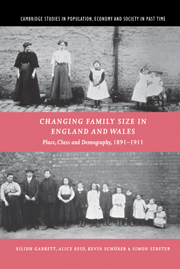Book contents
- Frontmatter
- Contents
- List of figures
- List of tables
- Preface and acknowledgements
- 1 Introduction
- 2 Locations for study
- 3 Studying locations
- 4 Infant and child mortality from the 1911 census
- 5 Fertility and fertility behaviour 1891–1911
- 6 The national picture
- 7 Class, place and demography: the mosaic of demographic change in England and Wales from Waterloo to the Great War
- Appendices
- References
- Index
- Cambridge Studies in Population, Economy and Society in Past Time
7 - Class, place and demography: the mosaic of demographic change in England and Wales from Waterloo to the Great War
Published online by Cambridge University Press: 05 January 2010
- Frontmatter
- Contents
- List of figures
- List of tables
- Preface and acknowledgements
- 1 Introduction
- 2 Locations for study
- 3 Studying locations
- 4 Infant and child mortality from the 1911 census
- 5 Fertility and fertility behaviour 1891–1911
- 6 The national picture
- 7 Class, place and demography: the mosaic of demographic change in England and Wales from Waterloo to the Great War
- Appendices
- References
- Index
- Cambridge Studies in Population, Economy and Society in Past Time
Summary
… however frugal, however unostentatious, however rational we may be, however resolute to live as we think we ought, and not as others do around us, it is … simply impossible not to be influenced by their example and to fall into their ways, unless we are content either to live in remote districts or in an isolated fashion.
Environment and demographic change
In chapter 1 it was argued that understanding of fertility and nuptiality change in England and Wales, particularly during the critical half-century before the 1911 Fertility Census, has been strongly constrained by the preoccupations of those compiling the original report from that census. Interpretation of the changes in the survival chances of young children also continues to be much influenced by the agenda set by late Victorian and Edwardian investigators. Chapter 1 concluded by holding out the prospect that the small but significant amount of individual-level ‘raw data’ from the 1911 census inquiry available to the present study would result in a range of new, relatively independent empirical findings. Has this volume succeeded in getting behind and going beyond the Edwardians' agenda? What have been the principal findings, and what directions for future research are indicated?
This concluding chapter will not attempt to recapitulate or summarise all the detailed points to emerge from the analyses reported in chapters 4 to 6. Rather it will try to draw out the principal findings of general significance – those which revise or challenge previous views of the ways in which fertility, nuptiality and mortality changed in England and Wales.
- Type
- Chapter
- Information
- Changing Family Size in England and WalesPlace, Class and Demography, 1891–1911, pp. 407 - 440Publisher: Cambridge University PressPrint publication year: 2001



